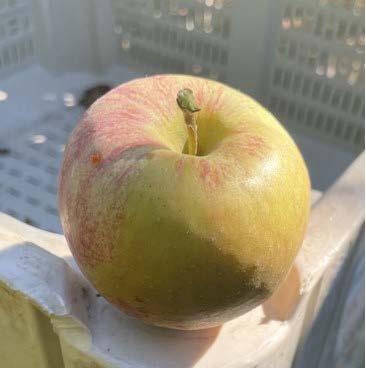Russet on Apples: Current Understanding and Management
What is russet on apples?
Russet on apples is a disorder of the skin that results in discoloration and changes to the expected smooth texture of the skin of apples. Russet appears as a spectrum from mild brown weblike pat-terns to severe rough changes on the surface of apples and many variations in between (Fig. 1). Russeting is only skin deep and thus will not affect the flesh of the fruit. It can occur due to naturally-occurring weather conditions, particularly humid and wet weather.
Russeting can ultimately reduce the market value of apples, decreasing grower profitability. Ac-cording to the US Department of Agriculture, the presence of russet disqualifies apples from the US Extra Fancy, US Fancy grades if smooth, solid russeting is more than 10%, while excessive russeting or smooth net-like russeting exceeding 25% excludes fruit from the US No. 1 grade categories.
Apples can begin to russet within the first 30-40 days of development, starting at petal fall. The earlier the tissues are damaged, the more dramatic the damage will be. But it is important to mention that russet can also be developed later during the growing season. Russeting occurs because cracks begin to develop underneath the cuticle of the apple. The damage in the epidermal cells underneath the cuticle turns brown. The cells are then pushed up-wards towards the skin because new cork cells are growing underneath the affected epidermal cells. Once the damaged cells reach the surface of the apple, they form phellogen, a wound-sealing tissue created as a result of the russeting reaching the surface. Although russeting affects the cosmetic ap-pearance of apples, it does not harm fruit flesh taste.
What factors cause or contribute to apple russeting?
Some cultivars produced by selective breeding are more prone to russeting than others as these can alter the genetic makeup of the apple to express russet. For example, Golden Delicious apples are highly susceptible to russet, while Red Delicious apples rarely express the russeting disorder.
Environmental and External Factors
There are many environmental factors that can cause russeting, and these can act alone or interact among them. Some of these include frost or cold temperatures during the season, rain or high humidity, intense sunlight, and burns resulting from the use of specific chemicals due to environmental conditions during application. These factors mainly act by impacting fruit growing rates, forcing their fluctuation. For example, drought can directly impact fruit growing rates, making them slow down, and then speed up, thus leading to the incidence of russeting. On the other hand, apples exposed to cool, cloudy weather during fruit rapid growth can also present an increase in russeting incidence. In the latter conditions, the non-blush side of apples has been reported to be prone to higher russeting due to the higher humidity content and failure of these to dry faster as a result of the shading that they are exposed to.
Russet can also result from the effect of chemical burns, which can result from environmental stress conditions; as they will be much more intense under high-temperature conditions than under cooler weather conditions. Additionally, prolonged periods of wetting the fruit when spraying can also lead to a higher russeting incidence due to higher chemical uptake of chemicals. Foliar fertilizers (e.g., Cu, Zn, Ca), surfactants, as well as carbamates (Vydate and carbaryl), and pesticides (sulfur or captan fungicides) are examples of chemical agents that can make fruit more prone to russet. Finally, pathogens such as powdery mildew can also be important agents for triggering russeting development in apple fruits.
What are the practices that can be implemented to prevent fruit russeting?
By understanding the genetic, environmental, and external factors that can cause fruit russeting, it is possible to identify the best practices that can be implemented to prevent it. Ideally, from a genetic perspective, the establishment of apple cultivars that are genetically more susceptible to russeting should be avoided when selecting cultivars for future orchards. Additionally, sprays of a mix of gibberellins (GA 4+7) have been proven effective for reducing skin disorders such as russeting, particularly when fruits are exposed to unfavorable environmental conditions.
These products act by making the apple skin more elastic. Generally, several sprays of this gibberellin mix at 10-day intervals starting at petal fall are recommended. Commercial products that contain this gibberellin mix as an active ingredient include Pro-Vide (Valent Biosciences) and Novagib (Fine Americas). In using these products, no use of surfactants or other spray additives is recommended. Another practice that can be used to decrease russeting includes the use of coatings, such as ParkaTM (Cultiva LLC). This coating acts by repelling water to reduce russeting from the buildup of water droplets on the surface of the apple.
This article appears in May 2023, Volume 14, Issue 3 of the Vegetable and Fruit News.
